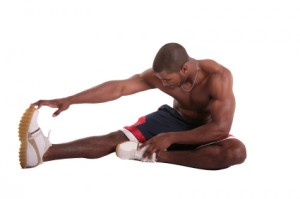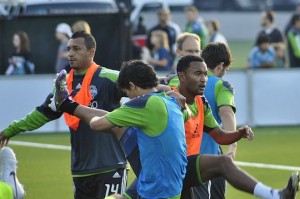Introduction
Let me set the scene for you. You are at the oval and your athletes are warming up prior to competition, and one calls out “can you come stretch my hammys?”. This is an obvious request for a PNF therapist-assisted stretch, and you will likely oblige for a few reasons, which may include:
- PNF stretching may have superior immediate effects for improving range of motion (Funk et al., 2003; Sharman et al., 2006).
- Normalising hamstring length may be important for injury prevention (Crosier, 2004). Interested? Check this out.
- An acute bout of stretching prior to exercise may be beneficial (Shrier, 2004)
However, today I would like to discuss some research that challenges the notion that PNF stretching deliver superior immediate improvements in range of motion. But first, a little background.
What Options Do We Have For Stretching?
I doubt that this will be news to anybody, but, when the sports physiotherapist is designing a stretching program there are essentially four options:
- Static Stretching
- Dynamic Stretching
- Ballistic Stretching
- Proprioceptive Neuromuscular Facilitation (PNF) (Voss et al., 1985)
The indications, dosages and efficacy of each technique are, well, variable. But in the above scenario we (or more accurately the hypothetical you) have selected a PNF technique to address lack of hamstring mobility. The important question we have to ask ourselves is; is a PNF technique the best in this case, and if so, why?
The Proposed Mechanisms of PNF Stretching
Whilst I am certain that you are fully aware of the proposed mechanisms of PNF stretching, I just thought it necessary to give you a quick revision. PNF stretching is thought to have its effect via 2 main pathways; autogenic and reciprocal inhibition (Sharman et al., 2006):
- Autogenic Inhibition: which refers to the reduction in the excitability of a contracted or stretched muscle attributed to increased inhibitory input, and subsequently decreased efferent drive, arising from the Golgi tendon organs
- Reciprocal Inhibition: which essentially refers to the inhibition that occurs in a muscle when there is a contraction of its antagonist.
It has been suggested that secondary to these two mechanisms PNF stretching delivers greater short-term improvements in ROM (Funk et al., 2003; Sharman et al., 2006). However, as previously stated some new research may question this belief…
Immediate Effects of Proprioceptive Neuromuscular Facilitation Stretching
Puenterdura and colleagues (2011) randomised 30 asymptomatic patients into two groups to compare the immediate effects of hold-relax PNF stretching to static stretching on hamstring length (Active Knee Extension). After one bout of stretching they found both intervention groups made statistically significant improvements when compared to controls, however, PNF stretching was not superior to static stretching (mean improvements in AKE were static stretching = 9.1º, PNF=8.9º, control=1.5º).
Hmm, so what can we take from this? It seems to suggest that in healthy individuals PNF stretching may not be more effective than static stretching for immediately improving range of motion. Of course this may not hold true in other populations, however, it certainly fits the clinical situation identified above which included an asymptomatic athlete prior to competition.
Implications for Clinical Practice
Given that static stretching is an independent option, with no therapist intervention required, you could suggest that this may be more appropriate for improving immediate range of motion. I have purposely stayed away from the concept of which is better for performance, as most would argue static stretching will decrease athletic performance (Papadopoulos et al., 2005). In which case a comparison between dynamic stretching, which may improve performance (Yamaguchi & Ishii, 2005), and PNF techniques may be more relevant to our clinical scenario. And don’t even get me started on the obvious requirement for long-term term comparison of the differences… we’ll save that for another day.
What Are Your Thoughts?
As always, I would like to know your thoughts and experiences. What are your thoughts on PNF stretching; love it or loathe it? Be sure to let me know in the comments or you could:
Promote Your Clinic: Are you a physiotherapist or physical therapist looking to promote your own clinic? Check this out.
Photo Credit: PhotoCapy, Albumen
References
Croisier, JL. (2004). Factors associated with recurrent hamstring injuries. Sports Medicine, 34(10), 681-695.
Folpp H, Deall S, Harvey LA and Gwinn T. Can apparent changes in muscle extensibility with regular stretch be explained by changes in tolerance to stretch? Australian Journal of Physiotherapy 2006;52: 45-50
Funk DC, Swank AM, Mikla BM, et al. Impact of prior exercise on hamstring flexibility: a comparison of proprioceptive neuromuscular facilitation and static stretching. J Strength Cond Res 2003;17(3):489-92
Handel M, Horstmann T, Dickhuth HH, Gülch RW. Effects of contract–relax stretching training on muscle performance in athletes. Eur J Appl Physiol Occup Physiol. 1997; 76: 400–8.
Papadopoulos, G. Siatras, Th. Kellis, S. The effect of static and dynamic stretching exercises on the maximal isokinetic strength of the knee extensors and flexors. Isokinetics and Exercise Science 2005: 13 (4)
Puenterdura EJ, Huijbregts PA, Celeste S, Edwards D, In A, Landers MR, Fernandez-de-las-Penas C. Immediate effects of quantified hamstring stretching: Hold-relax proprioceptive neuromuscular facilitation versus static stretching. Physical Therapy in Sport 2011;12:122-126
Sharman MJ, Cresswell AG, Riek S. Proprioceptive neuromuscular facilitation stretching: mechanisms and clinical implications. Sports Med 2006;36(11):929-939
Shrier, I .Does stretching improve performance?: A systematic and critical review of the literature. Clinical Journal of Sport Medicine 2004:14(5)
Voss, DE., Ionta, MK., & Myers, BJ. (1985). Proprioceptive neuromuscular facilitation: Patterns and techniques (3rd ed.). Lippincott Williams & Wilkins.
Yamaguhci, T & Ishii, K. Effects of static stretching for 30 seconds and dynamic stretching on leg extension power. The Journal of Strength and Conditioning Research 2005;19(3).






